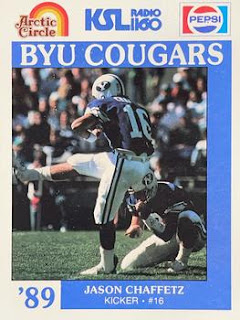#76 - 11/20/76 – Gifford Nielsen becomes 1st Cougar QB with 3,000+ yards as Cougars secure a tie for the WAC Title: BYU – 34, Utah - 12
As BYU prepared for its regular season finale, the Cougars (8-2) were still in the mix for the WAC title. However, if they wanted to earn a share of the conference championship, they needed to get by the Utah Utes (3-6). Although the Utes were finishing out a disappointing year, their season would earn some measure of redemption if they could knock off their rivals and keep them from earning their third conference championship.
The first quarter was a defensive battle. After only gaining 18 yards on their first possession, the Cougar offense got a boost when a lousy Utah punt set them up at the Ute 39. They advanced 33 yards to the Ute 6, where QB Gifford Nielsen bootlegged it in for the first score of the game. Dave Taylor’s extra point kick gave the Cougars a 7-0 lead.
Early in the second quarter, the Cougars marched 68 yards into Ute territory. Unfortunately, the drive came to an abrupt end when Nielsen’s pass was picked off at the Ute 2. Fortunately, the Cougar D came through again, forcing Utah’s fifth consecutive punt. Starting at midfield, the Cougars advanced to the Ute 3. Nielsen then lobbed a short TD pass to Mike Chronister for a 3-yard TD reception. The extra point attempt failed, and Utah’s offense finally started to move the ball, going 80 yards in 7 plays. A 3-yard TD rush by Steve Peake, and missed extra point, made it 13-6. The Cougars’ ensuing drive got off to a great start when Nielsen completed a 41-yard pass to Mike Chronister. A 15-yard penalty pushed them back to the 50. A 16-yard completion to Van Der Wouden got the yardage back, but Van Der Wouden fumbled the ball over to the Utes. The Cougar D came up with a big fourth-down stop at their own 33 to give the offense one more shot at adding to their lead before the half. With the clock running down, the Cougars quickly moved back into scoring position with a 30-yard completion to Van Der Wouden. With under a minute to play, Nielsen fired a 25-yard TD pass to George Harris to give the Cougars a 20-6 lead at the half.
When the third quarter opened, Utah marched 49 yards, but their drive ended with a missed FG attempt. The Cougars responded with an 80-yard drive that culminated with a 19-yard TD pass to Jeff Blanc, who was tackled as the entered the right corner of the end zone, but held on for the score. Utah moved to the Cougar 13 on its next drive, but the Cougar D drove them backwards on three consecutive plays to the 37. The 35-yard punt pinned the Cougars at their own 2-yard line. In response, the Cougars bared their claws and moved 96 yards in six plays. On the seventh, Nielsen pitched the ball to Dave Lowry on the option play, and Lowry raced into the end zone untouched for the score. Although the next two Cougar drives ended in interceptions, the Utes failed to capitalize. The Cougar lead was now 34-6 through three quarters of play.
The Cougars struggled to move the ball in the fourth, punting on their final four possessions. The Utes, on the other hand, refused to punt. Their final four drives ended with 3 failed fourth down attempts and one touchdown - a 2-yard pass from Pat Degnan to Dick Graham that made the final score a decisive 34-12 Cougar victory.
 |
| Gifford Nielsen jersey and photo BYU Legacy Hall |
In the victory, BYU’s All-American QB Gifford Nielsen became the first Cougar quarterback to throw for more than 3,000 yards in a season while leading the team to a 9-2 regular season record. Although they were unranked in the AP poll, the Cougars finished the regular season tied for #17 in the Coaches’ Poll. The win, combined with Wyoming’s loss to Air Force that same day, created a first place tie in the WAC, with BYU and Wyoming sporting identical 6-1 records. Because Wyoming beat BYU, they got the Fiesta Bowl invitation, but BYU was invited to play in the Tangerine Bowl. Although 3,000 passing yards may not seem like much in today’s game, Gifford’s 3,192 passing yards set a school record and was the fifth highest total in NCAA history at the time. His success firmly established BYU as a passing school, setting the standard that his successors would strive to emulate and surpass.



Comments
Post a Comment